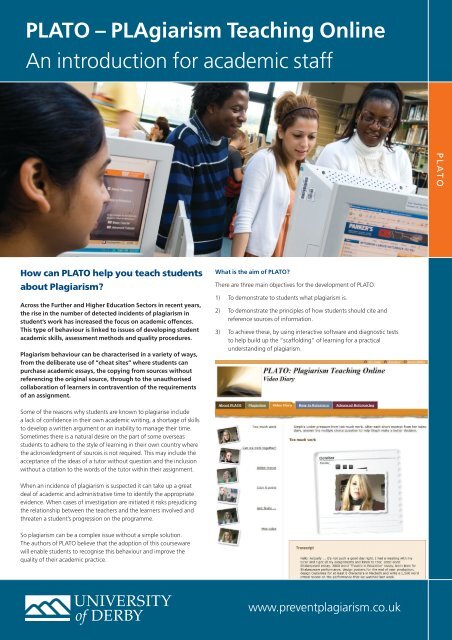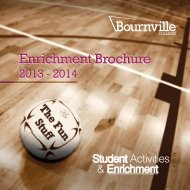Teaching Notes - Moodle@Bournville
Teaching Notes - Moodle@Bournville
Teaching Notes - Moodle@Bournville
- TAGS
- www.yumpu.com
You also want an ePaper? Increase the reach of your titles
YUMPU automatically turns print PDFs into web optimized ePapers that Google loves.
What is the pedagogical basis for PLATO?To help develop an understanding of plagiarism, PLATO begins with alow level of assumptions of prior knowledge and experience. Upon thisfoundation, the “scaffolding” of learning has been erected. This beginswith definitions of plagiarism from statements contributed by academicstaff and students from diverse cultural backgrounds.The student then progresses through practical demonstrations ofdifferent forms of plagiarism behaviour. The learner will haveopportunity to grasp the principles established in the first part of PLATO,“What is Plagiarism?” and return to them as appropriate.Likewise in the second part “Learn how to cite and reference”, there isan explanation of the principles involved with locating the informationto reference.PLATO then enables the learner to build on this knowledge by usingexamples from a wider variety of the resources.What methods are adopted in PLATO?A variety of tools are used to encourage and support the learner.These include the following:• Introducing diagnostic testing to help assess prior knowledge• Provision of specific feedback in response to testing and anopportunity for follow up practice• Making use of video, audio and interactive animation to underpinthe teaching of basic concepts of referencing• Opportunities to progress beyond basic materials to referencesources such as official publications and audio resourcesThis will lead to one of two options:Firstly for those learners with low scores in the “What Do You KnowAlready?” test, ask them to try the Basic Tutorial.Secondly for those with high scores in the “What Do You KnowAlready?” test ask them to try the Attainment Test.Use the “Advanced Tutorial” section to explore the varied approachesto identifying authors and examples of how to reference a varietyof materials.Finally ask learners to try sections of the Advanced Referencing Quiz.A total of 30 minutes approximately will be needed.This session could be extended further to include learners practisingreferencing skills using a range of different resources.Please remind students that they can reinforce their learning by accessingPLATO at any time via the VLE.If you would like further information about PLATO, please contactInnovation 4 Learning, University of DerbyE: info@preventplagiarism.co.ukT: 01332 591586W: www.preventplagiarism.co.ukPLATOWhat skills are required to use PLATO?A basic competency in using a PC mouse and keyboard.When is the most appropriate time to introduce PLATO?Initially in the first few weeks after induction and prior to the first assignment.Activities:Some suggestions for Classroom activities are:While introducing the concept of plagiarism try using “About Plagiarism”and you will find that it includes the following topics:• What are the principles of good academic practice?• Why should learners acknowledge their sources in academic work?• Defining what Plagiarism behaviour is, from “Plagiarism andOther Cheating”• A group work activity – look at “Forms of Plagiarism” and“Check Your Understanding”• A series of Case studies, “You are the Judge” that could formthe basis of group discussions about the scenarios and theadvice givenA total of 40 minutes approximately will be needed.You will need a PC Lab.If you are introducing practical skills of citing and referencing usethe section: “Know How to Reference”Ask learners to work in pairs or individually using “What Do YouKnow Already?” diagnostic test.www.preventplagiarism.co.uk





